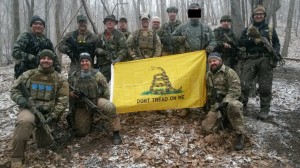AAR #5: CRCD 15-16 Mar 2014 – Alan W. Mullenax
AFTER ACTION REPORT
Max Velocity Combat Rifle/Contact Drills
March 15-16, 2014
Submitted by:
Alan W. Mullenax
The last time I participated in anything like this training was in the United States Army some forty years ago. Though the drills as a whole were somewhat tough, the terrain fairly rugged and the weather a little chilly at times, it was invigorating, fun and ultimately resulted in the acquisition of some extremely valuable training. The teaching/tactical environment that Max Velocity has created in a rather remote mountainous area of West Virginia allows participants to put into practice his professional instruction and in turn test mind, body and gear.
Max himself is without a doubt a professional soldier. His appearance, bearing and manner are indicative of this. During classroom sessions his presentation skills are impeccable utilizing a crawl, walk, run method. He believes in what he’s teaching and there is also no question of his desire for participants to absorb the instruction he is presenting. In short, he is a knowledgeable and capable military instructor.
While the training is what’s being paid for, it is a slight second to safety in importance. Make no mistake. This is true, live fire training. Participants are locked and loaded at all times. During drills, participants maneuver and engage targets down range while others are forward of the firing line, scenarios that would give most range safety officers a heart attack. But the training demands this and Max sets strict parameters and a set of commands to insure the highest level of safety for all participants. Personal responsibility is also of high importance. This is not a class for those who just picked up an AR yesterday. Basic weapon handling is not part of this training as it is with almost every square range class. Participants are expected to know how to operate their weapon and to always be cognizant of their muzzle and safeties at all times. The formula works. This writer never had an uncomfortable moment the entire week-end.
Participants should strive to be in as good a physical condition as possible before arrival for training. While Max is able to work with those in a less than able physical condition, understand that there is not a level piece of ground on the entire site. Participants are at all times walking up and/or down inclines, and loose leaves, mud and rocks affect footing. Drills have the participants maneuvering quickly and ideally going prone several times while fighting up and/or downhill. Even the best in shape are breathing heavy at the end of drills. Those in lesser physical condition are allowed to maneuver at their own pace and kneel or even stand instead of going prone during drills. There is no question that a participant’s physical condition will have an effect on his/her performance. This writer would suggest the inclusion of incline running or Stair Master with kit in addition to exercises such as push-ups and burpees into a PT program in preparation for this training. Repetitions of five yard dashes with a crash to prone would also be beneficial.
While at present around the blogs there is discussion of what kind of gear one should have and what load one should carry, in this writers opinion the requirements for this training could be in fact fairly minimal. The following is offered to convince those that think they have to have the gear and load of a special forces troop before signing up for training that it really isn’t necessary. Certainly a pair of boots or hiking shoes that provide good ankle support are of paramount importance. While recommended in the course requirements, this writer would consider knee pads essential. The ranges are fairly rocky. Crashing down to a prone position could expose an unprotected knee to a rock hidden in a carpet of leaves. In addition to a reliable weapon, at least four magazines with some manner of carriage like battle belt, chest rig or vest would be a necessity. There is plenty of time between drills to reload mags and this writer experienced no drill that required more than 90 rounds. Lastly, a drop pouch should be incorporated in the training gear. It will eliminate the need to police up empty mags before moving to a new position during a drill or having to search the range for left behind mags after a drill. For those that have a complete kit, great. The drills will allow you to check it out under realistic fire and movement. In other words, don’t agonize over gear, just get the training. Now! The training may actually help you decide what gear you want.
At present two ranges forming a rough “V” with a classroom shelter at the closed end comprise the training campus (Combat Patrol utilizes further areas). Range #1is the shorter and more open of the two. All drills conducted during the first day take place on this range. It also serves to prep participants for Range #2 called the “Jungle Walk” where all drills take place on the second day. This range is longer, more rugged and undulating, and has multiple targets and bunkers. Target presentation on both ranges is controlled by Max using radio frequency transmission. They are self recovering when hit and knocked down. The classroom shelter is equipped with a magnetic white board and chairs for the various lectures given throughout both days of training.
As previously stated, Max uses a crawl, walk, run method of instruction. Each block of this instruction consists of a lecture utilizing the whiteboard to illustrate and/or diagram a particular movement with its related concepts followed by practical work on a range in the form of a drill. This method takes participants from the initial individual RTR (return fire, take cover, return appropriate fire) drill to a full squad hasty attack on a bunker complex with all participants. In between, fire and movement by buddy pair builds to fire and movement by fire team covering attack and break contact by bounds with front contact and break contact with left or right contact by peeling. While day one on Range #1 allows the viewing by participants of all drills and targets by everyone, day two on Range #2, “Jungle Walk”, does not. Participants are given a scenario at the start of a particular drill and they have to patrol and scan until contact, then perform the fire and movement as dictated by the scenario without viewing any previous action.
The two days of instruction and drills emphasized the concept of shoot, move, and communicate. Without a doubt, upon completion of our final drill where we formed up in a squad of three fire teams and initiated a hasty attack on a bunker complex in a moderate snow fall, the importance of that concept was driven home. But we also realized the necessity of team work. Shooting, moving, and communicating as a team allows for survival in the cracks. And at the end of the day that’s really what Max is trying to impart.


